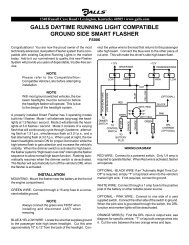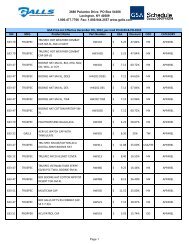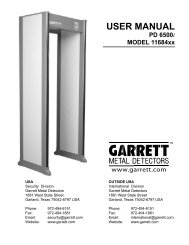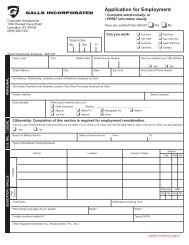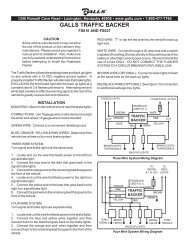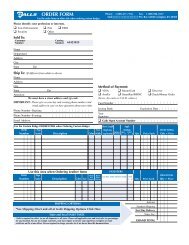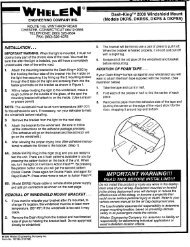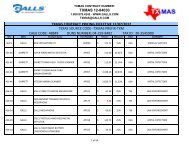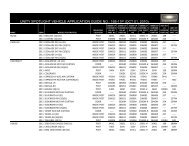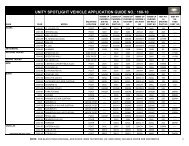ST160 - SS750 - Galls
ST160 - SS750 - Galls
ST160 - SS750 - Galls
You also want an ePaper? Increase the reach of your titles
YUMPU automatically turns print PDFs into web optimized ePapers that Google loves.
Street Thunder<br />
<strong>ST160</strong><br />
SIREN AMPLIFIER<br />
INSTALLATION AND OPERATING INSTRUCTIONS<br />
1340 Russell Cave Road / P.O. Box 54308 Lexington, KY 40505<br />
Tel: (800) 477-7766 Fax: (800) 944-2557<br />
Website: www.galls.com<br />
REV. - 10/9/03 PLITSTR314
INSTALLATION INFORMATION<br />
SERIAL NO: MODEL: <strong>ST160</strong><br />
PURCHASE DATE: OPTIONS<br />
DEALER: _____ Two-Tone Enabled<br />
INSTALLATION DATE: _____ Thunder/Man Auxiliary Override<br />
INSTALLER: _____ Thunder Disabled<br />
Model and serial number located on bottom of unit<br />
TABLE OF CONTENTS<br />
GENERAL DESCRIPTION 1<br />
INSTALLATION 2-6<br />
UNPACKING 2<br />
INSTALLER-SELECTABLE OPTIONS 2-3<br />
MOUNTING 4<br />
SAFETY PRECAUTIONS 4<br />
ELECTRICAL CONNECTIONS 4-6<br />
WIRING DIAGRAM 5<br />
OPERATION 7-9<br />
GENERAL 7<br />
POWER 7<br />
SELECTOR SWITCH 8<br />
MANUAL/HORN ROCKER SWITCH 8<br />
VOLUME CONTROLS 9<br />
MICROPHONE 9<br />
AUXILIARY INPUT 9<br />
PARK KILL 10<br />
SERVICE 10-12<br />
TROUBLESHOOTING 10<br />
SPECIFICATIONS 11<br />
LIMITED WARRANTY 11<br />
RETURN 12<br />
NOTICE<br />
Due to continuous product improvements, we must reserve the right to change any specifications and information, contained in this manual<br />
at any time without notice. <strong>Galls</strong> makes no warranty of any kind with regard to this manual, including, but not limited to, the implied<br />
warranties of merchantability and fitness for a particular purpose. <strong>Galls</strong> shall not be liable for errors contained herein or for incidental or<br />
consequential damages in connection with the furnishing, performance, or use of this manual.<br />
GENERAL DESCRIPTION<br />
The <strong>ST160</strong> Siren Amplifier is a premium 100W unit designed for single 100W<br />
speaker use. The primary operating modes are Thunder, Yelp, Wail, Hands Free,<br />
Manual, PA, and Radio. A Noise Canceling PA Override and push-button Horn<br />
Override are available in all modes. A manual push-button is provided for pushon/push-off<br />
tone toggle operation in the Thunder, Yelp, and Wail modes. It also<br />
allows manual siren control in the Manual or PA modes. The Thunder function can<br />
be optionally replaced by Two-Tone or disabled entirely with program jumpers.<br />
Another feature allows cycling through Wail, Yelp, Thunder, and Standby by<br />
providing a signal to the horn ring auxiliary wire when the function switch is in the<br />
Hands Free (HF) position. A Park Kill option is provided for connection to a door<br />
switch, etc. to disable the siren when exiting the vehicle. Radio and PA volume<br />
controls are provided on the front panel. The front panel is backlighted with LED's<br />
for night visibility. This compact unit utilizes short circuit, high voltage, low<br />
voltage, and reverse polarity protection systems for maximum service life.<br />
To Return Merchandise…<br />
You don't need to call us if you have a problem with the<br />
merchandise you've received. Simply follow the instructions on<br />
the reverse side of the packing slip that comes with your order.<br />
<strong>Galls</strong> provides a preaddressed label for you to affix to the<br />
package. If you don't have your packing slip, place the item in<br />
the original packaging (along with a brief explanation for the<br />
return), then place in a second box to prevent damage. To assure<br />
speedy handling, please ship it directly to:<br />
<strong>Galls</strong>, Inc. Returns Department<br />
1340 Russell Cave Road, Lexington, KY 40505<br />
If you have any questions concerning this or any other Gall's product,<br />
please contact our Customer Service Department at (800) 477-7766.<br />
-1- -12-<br />
No Hassle Guarantee<br />
Providing quality products to professionals who<br />
protect and serve the public is our core purpose.<br />
If you aren’t satisfied with a newly purchased item, simply return<br />
it to us so we can repair it, replace it or refund your money.
SPECIFICATIONS<br />
Input Voltage 10 - 16 VDC (negative ground)<br />
Input Current 8.0 Amps @ 13.6 VDC (single 100W speaker)<br />
Standby Current Less than 150 mA<br />
Audio Frequency 200Hz - 10 kHz + 3db<br />
Audio Output 40 watts @13.6 VDC<br />
Output Power 105 WATTS RMS MAX. (15.0 VDC - single 100W speaker)<br />
Siren Frequency 675Hz - 1633Hz<br />
High Voltage Protection 16 - 18 VDC will cause siren output to cease, resumes at normal voltage<br />
Short Circuit Current 50 AMPS (supply circuit must be capable of supplying this)<br />
Operating Temperature -15° F to +140°F<br />
Controls 7-position rotary switch (Radio, PA, Manual, HF, Wail, Yelp, Thunder)<br />
Momentary Manual/Horn rocker switch<br />
Auxiliary input (jumper programmable) for positive or negative horn<br />
-Remote Manual or Hands Free operation<br />
Park Kill input (jumper programmable) for positive or negative activation<br />
Thunder (and Two-Tone) disable (jumper programmable)<br />
Two-Tone activation (swaps modes with Thunder) (jumper programmable)<br />
Connections<br />
(12-Pin Connector)<br />
Detachable, 12-pin, positive locking connector with pigtail leads.<br />
(1) Positive, (1) Negative, (1) Activation (on/off), (1) Backlighting,<br />
(2) Speaker, (2) Radio, Auxiliary, Park Kill<br />
Size 6" Wide, 6-1/2" Deep, 2-1/2" High<br />
Shipping Weight 6 lbs.<br />
LIMITED WARRANTY<br />
<strong>Galls</strong> warrants this new product to be free from defects in material and workmanship, under<br />
normal use and service, for a period of seven (7) years from the date of delivery to the first<br />
user-purchaser.<br />
During this warranty period the obligation of <strong>Galls</strong> is limited to repairing or replacing, as<br />
<strong>Galls</strong> may elect, any part or parts of such product which after examination by the<br />
manufacturer is determined to be defective in material and/or workmanship.<br />
This warranty does not cover labor charges for removal or re-installation of the product.<br />
Fuses and lamps are not covered under this warranty.<br />
This warranty does not extend to any unit that has been subjected to abuse, misuse, improper<br />
installation or which has not been adequately maintained, nor to units which have problems<br />
related to service or modification at any facility other than the manufacturer.<br />
THERE ARE NO OTHER WARRANTIES, EXPRESSED OR IMPLIED, INCLUDING BUT<br />
NOT LIMITED TO, ANY IMPLIED WARRANTIES OF MERCHANTABILITY OR FITNESS<br />
FOR A PARTICULAR PURPOSE. IN NO EVENT SHALL GALLS AND/OR THE<br />
MANUFACTURER BE LIABLE FOR ANY LOSS OF PROFITS OR ANY INDIRECT OR<br />
CONSEQUENTIAL DAMAGES ARISING OUT OF ANY SUCH DEFECT IN MATERIALS<br />
OR WORKMANSHIP.<br />
INSTALLATION<br />
Proper installation of the unit is essential for years of safe, reliable operation.<br />
Please read all instruction before installing the unit. Failure to follow these<br />
instructions can cause serious damage to the unit or vehicle and may void<br />
warranties.<br />
Qualifications - The installer must have a firm knowledge of basic electricity,<br />
vehicle electrical systems and emergency equipment.<br />
Keep These Instructions - Keep these instructions in the vehicle or other safe place<br />
for future reference. Advise the vehicle operator of the location.<br />
Unpacking - Inspect contents for shipping damage. If found, alert carrier<br />
immediately. Contents should include unit with microphone, mounting bracket w/ 2<br />
bolts, microphone bracket with 2 screws, wiring harness with connector, and these<br />
instructions. Contact your supplier immediately if any components are missing.<br />
Installer Selectable Options (Jumper Settings)<br />
The <strong>ST160</strong> has several options that can be selected during installation. Jumpers on<br />
the printed circuit board, inside the case, allow the installer to select these various<br />
options. These options should be set before installation of the unit.<br />
Cover Removal - Remove the four Philip head screws located on the back of the<br />
unit. DO NOT REMOVE THE SCREWS ON THE FRONT OF THE UNIT! Slide<br />
the top cover back and away from the front face of the unit. This cover can be<br />
removed completely from the siren unit. CAUTION!!! DO NOT OVER-TIGHTEN<br />
SCREWS.<br />
After the cover has been removed, find the location of the option jumpers (see<br />
diagram below).<br />
-11- -2-
Auxiliary Input Polarity - The auxiliary input (green wire) is normally activated by<br />
applying a positive voltage to the wire. To activate by connecting to ground<br />
(negative), move the jumper from the "AUX-POS" pins to the "AUX-NEG" pins.<br />
Park Kill Input Polarity - The park kill (cutout) input turns off any siren tone<br />
output when activated (i.e. vehicle shifted into park, door opened, etc.), and remains<br />
off until a control on the siren is activated or changed. The wiring diagram on page<br />
5 shows two connection examples.<br />
The park kill input is normally activated by connecting the gray wire to positive<br />
voltage. To activate by connecting it to ground (negative) instead, move the jumper<br />
from the "PK-POS" pins to the "PK-NEG" pins.<br />
Auxiliary Input Function - The auxiliary input (green wire) allows activation by an<br />
external source of either the Horn or the Manual push-button functions. This input is<br />
usually wired into the vehicle horn switch. The wiring diagram on page 5 shows two<br />
connection examples. NOTE: Permanent disconnection of the vehicle horn is NOT<br />
recommended.<br />
The siren is factory shipped with the auxiliary input option defaulted as the Horn<br />
function (on only one of the "AUX" pins). To utilize the auxiliary input as the<br />
Manual function instead of the Horn function, move the "AUX" jumper from one pin<br />
onto both of the pins.<br />
Two-Tone – The Thunder sound can be replaced by a Two-Tone sound by moving<br />
the "TT" jumper from one pin onto both of the "TT" pins.<br />
Thunder Disable - The Thunder function can be completely disabled by moving the<br />
"TD" jumper from one pin to both pins. This will also disable the Two-Tone<br />
function used when the manual button is pressed while the mode switch is in the<br />
Thunder position.<br />
SERVICE<br />
This unit is designed to provide years of reliable service under even the worst<br />
conditions. Many times there may appear to be a problem with the unit when the<br />
true problem is in the speaker(s) or improper installation. The following chart<br />
shows typical symptoms and possible causes.<br />
TROUBLESHOOTING<br />
Symptom Possible Cause Check<br />
No power Yellow wire is not powered<br />
Connector loose<br />
Siren 15A fuse blown<br />
-3- -10-<br />
Is yellow wire connected to switched +12VDC?<br />
Check connector<br />
Is power hooked up backwards? Positive ground vehicle?<br />
Is an external fuse or circuit breaker used?<br />
Are the negative leads connected to a good ground?<br />
The input voltage must be less than 16 volts.<br />
The input must be greater than 10V with the siren turned on.<br />
Does microphone button release properly?<br />
Is the PK jumper option properly configured?<br />
Does the siren work when Park Kill input is disconnected?<br />
Check for a short.<br />
Check for an open.<br />
Loose connection at power source<br />
No siren tone - PA High voltage protection<br />
works<br />
Low voltage protection<br />
Microphone button stuck<br />
Park Kill polarity option set wrong<br />
Park Kill activated<br />
No siren tone - No Bad speaker or speaker wiring<br />
sound<br />
No PA PA volume not set properly Have you tried turning the PA volume control?<br />
Distorted siren<br />
sound<br />
Speaker assembly loose<br />
Intermittent Aux. Input connection<br />
Low or high vehicle voltage<br />
Is the speaker bell or tip loose?<br />
Is the Aux. Input used and wired properly?<br />
Input voltage must be between 10 & 16 volts while siren is on.<br />
Intermittent siren<br />
tone<br />
High voltage protection<br />
Low voltage protection<br />
Is the vehicle voltage regulator working properly?<br />
Is the connector tight on the back of the unit? Is there a loose<br />
connection on a power lead? The input must be greater<br />
than 10V with the siren turned on.<br />
Microphone button activation<br />
Is something lying on the microphone?<br />
Circuit breaker in supply connection<br />
Shorted speaker or speaker wire<br />
Is a circuit breaker used with at least a 50A rating?<br />
Does the speaker have water damage, or is a wire pinched?<br />
Horn function or Manual/Horn rocker switch stuck Does the switch return fully when released?<br />
Manual or<br />
Thunder stuck on<br />
Aux. Input improperly connected<br />
Aux. Input Polarity Option set wrong<br />
Is the Aux. Input used and wired properly?<br />
Is the AUX jumper option properly configured?<br />
No Radio Unit not connected to radio<br />
Is the radio connected properly to the unit?<br />
Radio volume too low<br />
Can you hear the radio in the vehicle?<br />
Have you tried turning the Radio volume control?<br />
No or Low Radio Radio outputs not isolated and polarity Are the radio wires connected to the correct polarity from the<br />
hooked up backwards<br />
radio output?<br />
Wrong siren tone Two-Tone option jumper installed Is the TT jumper option properly configured?<br />
Aux. Input set to wrong function Is the AUX jumper option configured properly?<br />
Thunder not Thunder disabled Is the TD jumper option configured properly?<br />
working
VOLUME CONTROLS<br />
The radio repeat volume (Radio) control is recessed in<br />
the upper left hand corner of the front face. This<br />
should be set when the vehicle is parked. First set the<br />
volume level of the vehicle's two-way radio to its<br />
normal operating volume. Adjust the siren's rotary<br />
selector switch into the RADIO position. Insert a<br />
small, flat blade screwdriver into the RADIO volume<br />
adjustment port. Turn clockwise direction to increase<br />
the sound level.<br />
The PA volume (PA Vol.) control is provided for public<br />
address volume. It is located in the upper right hand corner<br />
of the front face. This should be set when the vehicle is<br />
parked. Set the PA volume to the maximum level with no<br />
feedback (squeal).<br />
MICROPHONE<br />
The attached noise-canceling microphone is used for public address operation and<br />
overrides any siren tone when its push-to-talk (button on the side) is pressed.<br />
AUXILIARY INPUT<br />
During installation an auxiliary input may be connected to the vehicle horn ring or<br />
other switching device. It provides the same operation as pressing the Horn button<br />
or optionally (via internal jumpers) the Manual rocker switch.<br />
PARK KILL (CUTOUT)<br />
During installation, the Park Kill input may be connected to a door switch. It will<br />
automatically turn off any siren tone when the door is opened. The siren tone will<br />
continue to be cut off even when the door is closed. Changing any switch or input<br />
will restore normal function.<br />
MOUNTING<br />
SAFETY PRECAUTIONS<br />
For the safety of the installer, vehicle operator, passengers and the community<br />
please observe the following safety precautions. Failure to follow all safety<br />
precautions and instructions may result in property damage, injury or death.<br />
!!! WARNING !!!<br />
DO NOT mount in air bag deployment area.<br />
Devices should be mounted only in locations listed in SAE standard J1849.<br />
Controls should be placed within convenient reach of the driver.<br />
Assure clearances before drilling in vehicle.<br />
To prevent internal damage, the mounting bolts must not enter case more<br />
than 1/4".<br />
Sound levels produced by attached speakers can cause permanent hearing loss.<br />
Never operate this unit without adequate hearing protection for you and others<br />
in the area. (OSHA 1910.95)<br />
The <strong>ST160</strong> siren may be mounted above the dash, below the dash, on a tunnel, or in<br />
a rack with the mounting u-bracket provided. Choose a mounting location<br />
convenient to the operator and away from any air bag deployment areas. Inspect<br />
behind mounting area for clearance. Assure adequate ventilation to prevent<br />
overheating. Consider wire routing and access to connections, as well as<br />
microphone bracket placement. Install mounting bracket to vehicle using 1/4"<br />
hardware (not supplied). Drill two 1/8" size holes, and install microphone clip<br />
using the two screws provided with the clip.<br />
ELECTRICAL CONNECTIONS<br />
Electrical connections to the unit are made using a removable connector located on<br />
the back. If the unit needs service the connector can be easily removed without<br />
unwiring the connector.<br />
The power supply of the unit must be capable of delivering peak currents up to 50<br />
amps for adequate short circuit protection and reliable operation. The preferred<br />
source is directly at the vehicle battery. The unit is internally fused. A wiring<br />
diagram on the next page shows detail of how to wire the siren to the vehicle.<br />
-9- -4-
+12 VDC<br />
+12 VDC<br />
VEHICLE<br />
HORN<br />
Horn<br />
Switch/Relay<br />
VEHICLE<br />
HORN<br />
Horn<br />
Switch/Relay<br />
ON/OFF Power Switch for Siren<br />
(Possibly Connected to Ignition)<br />
+12 VDC<br />
Negative<br />
Switching AUX<br />
Horn Jumper<br />
Selected<br />
OR<br />
Positive<br />
Switching AUX<br />
Horn Jumper<br />
Selected<br />
Backlighting Switch (Connect to<br />
Dash Lights, Parking Lights, Etc.)<br />
+12 VDC<br />
SPEAKER<br />
11 OHMS<br />
+<br />
12 - Brown (#14 AWG)<br />
11 - Yellow (#18 AWG)<br />
10 - Green (#18 AWG)<br />
9 - Orange (#18 AWG)<br />
8 - Grey (#18 AWG)<br />
7 - Brown (#14 AWG)<br />
6 - Blue (#18 AWG)<br />
5 - No Connection<br />
4 - No Connection<br />
3 - Blue (#18 AWG)<br />
2 - Black (#14 AWG)<br />
1 - Red (#14 AWG)<br />
SIREN<br />
Negative Switching PK<br />
Jumper Selected<br />
OR<br />
Positive Switching PK<br />
Jumper Selected<br />
Dome<br />
Light<br />
+12 VDC<br />
Door Switch<br />
Added Door<br />
Switch<br />
Connect the Blue wires to<br />
the terminals of speaker or<br />
to the output jack of radio<br />
+ RADIO<br />
BATTERY<br />
+<br />
MANUAL / HORN MOMENTARY ROCKER SWITCH<br />
The front panel of the <strong>ST160</strong> contains a<br />
momentary rocker switch that operates the<br />
Manual function when the left side is<br />
depressed and the Air Horn when the right<br />
side is depressed.<br />
-5- -8-<br />
Manual – Pressing the left side of this momentary rocker switch provides a<br />
generally quicker changing tone when the selector switch is in the Wail, Yelp or<br />
Thunder positions. (See table below). These quicker tones are used at<br />
intersections and very highly congested areas. Pressing the button once changes<br />
to the next faster tone and pressing again changes the tone back to original tone.<br />
With the selector switch in the Manual, PA or Hands Free position this switch<br />
provides a manually activated Wail siren tone while the button is being held.<br />
This is used to momentarily alert motorists or in low noise areas.<br />
Optional operation includes replacement of the Thunder tone with Two-Tone or<br />
disabling the Thunder tone entirely. These options are selected during installation<br />
and may be governed by State or Local laws.<br />
With Rotary Switch Pressing the MANUAL Rocker Switch<br />
in this Position: Does This:<br />
THUNDER Toggles the Output to TWO-TONE<br />
YELP Toggles the Output to THUNDER<br />
WAIL Toggles the Output to YELP<br />
HF (Hands Free) Creates a manual WAIL tone while button is being<br />
held that sweeps down when the button is released.<br />
MAN (Manual) Creates a manual WAIL tone while button is being<br />
held that sweeps down when the button is released.<br />
PA Creates a manual WAIL tone while button is being<br />
held that stops immediately when the button is<br />
released.<br />
(NOTE: THUNDER and TWO-TONE may be optionally swapped or disabled via<br />
program jumpers. See INSTALLER-SELECTABLE OPTIONS on pages 2-3.)<br />
Air Horn – Pressing the right side of this momentary rocker switch provides a<br />
simulated air-horn tone while pressed. This can be used to either replace, or to<br />
supplement the normal vehicle horn and is useful at intersections or in low noise<br />
areas. This tone will override all other siren tones.
Wire Size and Termination - The wiring diagram on the previous page shows the<br />
minimu m wire size used for each connection, along with recommended lead color.<br />
If the wire is longer than 10 ft. then use the next larger wire size. Use only high<br />
quality crimp connectors. Make sure all connections are tight. Route wiring to<br />
prevent wear, overheating and interference with air bag deployment. Use<br />
grommets and sealant when passing through compartment walls. Minimize the<br />
number of splices to reduce voltage drop. Ground connections should only be<br />
made to substantial chassis components, preferably directly to the negative of the<br />
vehicle battery. Install and check all wiring before connection to vehicle battery.<br />
Wiring Connections:<br />
BLACK LEAD: Connect to the negative of the battery, or to a good chassis<br />
ground. Be sure to use minimum size #14 AWG wire.<br />
RED LEAD: Connect to the positive side of the battery, or to a high current<br />
power buss. A power relay may also be used. Be sure to use minimum size<br />
#14 AWG wire.<br />
YELLOW LEAD: Connect to +12VDC through a switched power supply<br />
(possibly ignition). This will turn the siren on and off. Be sure to use<br />
minimum size #18 AWG wire.<br />
ORANGE LEAD: This lead supplies power for the backlighting of the siren.<br />
Connect it to +12VDC from the dash lights, parking lights or other switched<br />
source. Be sure to use minimum size #18 AWG wire.<br />
BROWN LEADS: Connect one lead to each terminal or lead of the speaker. Be<br />
sure to use minimum size #14 AWG wire.<br />
Optional Connections:<br />
BLUE LEADS: Used for radio repeat. Connect one blue lead to each terminal<br />
of the radio speaker or output connector of the radio. Most radio outputs are<br />
isolated, in which polarity would not be important. Radios with polarity<br />
sensitive outputs should be connected w/ the blue wire from pin 6 to the<br />
positive radio output, and the blue wire from pin 3 to the negative radio<br />
output. Use #18 AWG wire.<br />
GREEN LEAD: Used for remote Manual control. Connect to the horn ring<br />
circuit or a remote switch. Circuit may be positive or negative with proper<br />
jumper selection. See INSTALLER-SELECTABLE OPTION section (page<br />
2) for jumper details.<br />
NOTE: Cut lead short if not used & insulate w/ electrical tape.<br />
GRAY LEAD: Used for Park Kill (Cut-off). Connect to dome light or added<br />
door switch. Circuit may be positive or negative with proper jumper<br />
selection. See INSTALLER-SELECTABLE OPTION section (page 2) for<br />
jumper details.<br />
NOTE: Be sure to cut lead short if not used and insulate with electrical tape.<br />
Testing - Test all siren functions after installation to assure proper operation.<br />
Test vehicle operation to assure no damage to vehicle.<br />
OPERATION<br />
GENERAL<br />
This unit is designed for easy operation under the stress associated with high-speed<br />
pursuit. Most siren functions are accessible with one simple motion without<br />
repetitive activation of switches or automatic timed switching that can interfere with<br />
desired operation.<br />
SELECTOR SWITCH<br />
Whenever +12VDC is applied to the yellow<br />
wire, the <strong>ST160</strong> will be "on". The rotary<br />
selector switch controls the primary<br />
operating function of the siren.<br />
Thunder - Ultra-fast changing tone<br />
used for maximum attention.<br />
Yelp - A rapidly changing tone<br />
used in congested areas.<br />
-6- -7-<br />
Wail - A slower changing tone used on<br />
highways.<br />
HF (Hands Free) - Also known as Horn Ring Cycler, allows the user to cycle<br />
through Wail, Yelp, Thunder and Manual by repeatedly pressing the<br />
horn or other switch connected to the AUX input. Operating any<br />
other switch resumes normal operation. Please note that this mode<br />
disables the Manual push-button selection when a Wail, Yelp, or<br />
Thunder tone is cycled to.<br />
Manual - A silent mode that allows push-button Manual, push-button Horn,<br />
and Public Address operation. The siren output winds down when<br />
the Manual momentary rocker switch is released.<br />
PA - A silent mode that allows push-button Manual, push-button Horn<br />
and Public Address operation. The siren output terminates<br />
immediately when the Manual momentary rocker switch is released.<br />
Radio - Also known as Radio Repeat, this function amplifies a radio speaker<br />
input for re-broadcast outside the vehicle. The PA remains<br />
functional, but no siren tones are available in this position.



